Missouri University of Science and Technology
Missouri S&T, or Missouri University of Science and Technology, is a public land grant and space grant university in Rolla, Missouri. It is a member institution of the University of Missouri System. Most of its 8,096 students (fall 2019)[10] study engineering, business, sciences, and mathematics. Known primarily for its engineering school, Missouri S&T offers degree programs in business and management systems, information science and technology, sciences, social sciences, humanities, and arts.
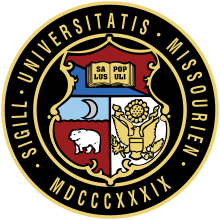 | |
Former names | Missouri School of Mines and Metallurgy (1870–1964) University of Missouri at Rolla (1964–1968) University of Missouri–Rolla (1968–2008) |
|---|---|
| Motto | Salus populi suprema lex esto (Latin) |
Motto in English | Let the welfare of the people be the supreme law[1][2][3] |
| Type | Public Land grant Space grant |
| Established | 1870 |
| Endowment | $190.8 million (2018)[4] $1.75 billion (system-wide, FY18)[5] |
| Chancellor | Mohammad Dehghani[6] |
| Provost | Stephen Roberts (interim)[7] |
Academic staff | 373 (full-time, fall 2017)[8] |
Administrative staff | 848 (full-time, fall 2018)[9] |
| Students | 8,096 (fall 2019)[10] |
| Undergraduates | 6,462 (fall 2019)[10] |
| Postgraduates | 1,634 (fall 2019)[10] |
| Location | , , U.S. |
| Campus | Rural, 284-acre (0.4 sq mi; 114.9 ha)[11] |
| Colors | Silver, gold and green[12] |
| Nickname | Miners |
Sporting affiliations | NCAA Division II – GLVC |
| Mascot | Joe Miner[13] |
| Website | www |
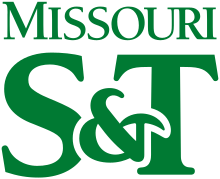 | |
History

Missouri S&T was founded in 1870 as the Missouri School of Mines and Metallurgy (MSM), the first technological learning institution west of the Mississippi River. Early in its history, the School of Mines was focused primarily on mining and metallurgy. Rolla is located close to the Southeast Missouri Lead District which produces about 70% of the U.S. primary supply of lead as well as significant amounts of the nation's zinc.[14]
The school was founded under the auspices of the University of Missouri in Columbia in order to take advantage of the Morrill Land-Grant Acts to "teach such branches of learning as are related to agriculture and the mechanic arts, in such manner as the legislatures of the States may respectively prescribe, in order to promote the liberal and practical education of the industrial classes in the several pursuits and professions in life."[15] The act endowed Missouri a federal land grant of 30,000 acres for each of the state's two senators and nine representatives at the time—or 330,000 acres (133,546.26 ha; 515.62 sq mi). The endowment said that the land could not be sold for less than $1.25/acre and as such as was a minimum endowment of $412,500 for Missouri. There was an intense debate in the state over the location and number of schools before it was finally decided to have one school in Columbia and a branch in the mining area of southeast Missouri.[16]
Iron County, Missouri (Ironton, Missouri) and Phelps County, Missouri (Rolla) made bids for the school. Iron County's bid was valued at $112,545 and Phelps County's bid was $130,545 so the Phelps bid was officially approved on December 20, 1870.[16]
Classes began in November 23, 1871 in a new Rolla High School building that the city of Rolla had just built. The college had an enrollment of 28 and three graduates in 1874.[16] The college bought what is now called the "Rolla Building" for $25,000 in January 1875. That building is now used as the Mathematics and Statistics Department's library, chair's office, part of the main office, and other faculty offices following a $2 million renovation in 1995.[17]
By the 1920s, the school expanded into civil, electrical, mechanical and chemical engineering as well as chemistry, physics, mathematics and geology. The school became home to Missouri's first operational nuclear reactor in 1961.[18]
In June 2018, the school was approved by the state's Coordinating Board for Higher Education for designation as "highly selective" in its undergraduate admission criteria, joining only Truman State University among the state's public universities at that level. As such, first-time, full-time students seeking degrees are generally only admitted if they have a "percentile score" of 140 points or greater, a combination of their high school class and college testing (ACT or SAT) percentile ranks.[19] Missouri Department of Higher Education guidelines state that schools in this category may admit up to ten percent of students with lower percentile scores, and will automatically admit those with an ACT (or equivalent SAT) score of 27 or better.[20]
Changes in hierarchy and name
Until 1964, the school was considered an offsite department of MU's School of Agriculture and Mechanical Arts, reporting to the main campus in Columbia (although it began fielding sports teams in 1935 in the Mid-America Intercollegiate Athletics Association). As such, its presiding officer was originally called a director (1871–1941), then a dean (1941–1964).[21] In 1963 the University of Missouri System was created with the additions of standalone campuses in Kansas City and St. Louis. A year later, MSM was upgraded to an autonomous standalone campus as the University of Missouri at Rolla and its presiding officer, like that of its sister schools, was granted the title of chancellor. The curriculum was expanded to include most of the science and engineering disciplines, as well as social sciences and liberal arts such as psychology and history. In 1968, the campus name was slightly altered to the University of Missouri–Rolla, thus conforming to the naming scheme of the other three campuses. Business and management programs were gradually added in the following years. On January 1, 2008 UMR became known as Missouri University of Science and Technology or Missouri S&T for short.[22]
In making the case for changing the name, then Chancellor John F. Carney III noted that Rolla in 2007 was "one of the few technological research universities in the nation. A technological research university (polytechnic university or institute of technology) may be defined as one in which a majority of students are enrolled in engineering, the sciences, business or mathematics; the graduate and research programs in those fields are robust; and exceptional academic programs in the liberal arts, humanities and social sciences complement and provide context to the technological strengths of the institution."
He noted that more than 70 percent of its enrollment was in engineering and more than 90 percent was in engineering, business, science and math—significantly higher than engineering schools such as the Massachusetts Institute of Technology, Georgia Institute of Technology, and Rensselaer Polytechnic Institute. He noted "The university’s name, however, does not reflect the distinctive nature of the campus. Often, UMR is viewed as a 'satellite' or 'branch' campus due to its name or as a 'feeder' campus for the University of Missouri-Columbia (commonly referred to as the University of Missouri). This branch-campus designation hinders many of our efforts to achieve national recognition and a strong reputation as a technological research university."[23][24]
He noted, "Of the 1.1 million seniors in the nation who took the ACT in 2006, only 551 non-Missouri seniors – or .05 percent – sent their scores to UMR." He also noted that the school's acronym of UMR got it confused with the University of Minnesota Rochester.[23]
Among the other names that were considered were Missouri University of Science and Engineering, Missouri Technological University, and Missouri Science and Engineering University.[24]
Chancellors
The naming structure for the head of the university has changed reflecting its changes through the years. The head currently reports to the University of Missouri system.[25][26]
The chancellor lives on campus at the Chancellor Residence (constructed in 1889 as the "Club House" dormitory, converted to a room house, before becoming the Missouri State Geological Survey headquarters and finally becoming the residence for the then-director in 1905).[27]
In August 2018, a committee was announced to lead a nationwide search for the next chancellor, the office having been filled on an interim basis since May 2017.[28] In May 2019, Mohammad Dehghani of Stevens Institute of Technology was announced as the next Missouri S&T chancellor, to begin service in August 2019.[29] Dehghani had previously held leadership positions at the Lawrence Livermore National Laboratory, the Applied Physics Laboratory, and the Johns Hopkins University Systems Institute, at which he was a founding director.[30]
- Charles Penrose Williams, Director, 1871–77
- Charles Edmund Wait, Director, 1877–88
- William Holding Echols, Director, 1888–91
- Elmo Golightly Harris, Director, 1891–93
- Walter Buck Richards, Director, 1893–97
- George E. Ladd, Director, 1897–07
- Lewis Emmanuel Young, Director, 1907–13
- Leon Ellis Garrett, Acting Director, 1913–15
- Durward Copeland, Director, 1915
- Austin Lee McRae, Director, 1915–20
- Charles Herman Fulton, Director, 1920–37
- William Reuel Chedsey, Director, 1937–41
- Curtis L. Wilson, Dean, 1941–63
- Merl Baker, Dean 1963–1964, Chancellor 1964–73
Dudley Thompson, Acting Chancellor, 1973–74 - Raymond L. Bisplinghoff, Chancellor, 1974–76
Jim C. Pogue, Interim Chancellor, 1977–78 - Joseph M. Marchello, Chancellor, 1978–85
John T. Park, Interim Chancellor, 1985–86 - Martin C. Jischke, Chancellor, 1986–91
- John T. Park, Chancellor (initially interim), 1991–2000
- Gary Thomas, Chancellor, 2000–05
- John F. Carney III, Chancellor, 2005 – August 2011
Warren K. Wray, Interim Chancellor, September 2011 – March 2012[31] - Cheryl B. Schrader, Chancellor, April 2012 – May 2017[32][33][34]
Christopher G. Maples, Interim Chancellor, May 2017 – July 2019[35] - Mohammad Dehghani, Chancellor, August 2019 – present[6]
Campus
Missouri S&T Stonehenge
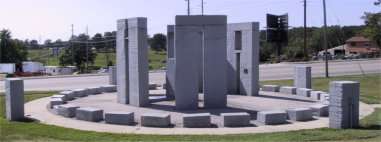
Missouri S&T Stonehenge is a partial reconstruction of the original Stonehenge monument located on Salisbury Plain, in southern England. Missouri S&T's version of the ancient structure is located on the northwest corner of campus, and was dedicated on June 20, 1984 during the summer solstice. It features a 50-foot (15 m) diameter ring of 30 stones around a horseshoe of five trilithons through which various sightings of sunrise and sunset can be made. About 160 tons of granite were used to construct the monument. The rock was cut by Missouri S&T's water jet cutter equipment, which used two waterjets cutting at a pressure of 15,000 pounds of force per square inch (103 MPa), slicing across the surface just like a conventional saw. The cutter moved at a speed of about 10 feet per minute (50 mm/s) and cut between one-quarter and one-half inch (6 and 13 mm) on each pass.[36]
After completion, Missouri S&T Stonehenge received an award from the National Society of Professional Engineers for being one of 1985's Ten Outstanding Engineering Achievements.[37]
Millennium Arch
The university developed a new way to make deep cuts in granite and worked with artist Edwina Sandys who used the method to create the Millennium Arch sculpture. The Arch is a single trilithon with the stylized silhouettes of a man and a woman cut from the two uprights. The figures cut from the uprights stand nearby as freestanding statues. The work, which is located on 10th Street facing Castleman Hall, was developed as a project of the High Pressure Waterjet Laboratory of the Rock Mechanics & Explosive Research Center at Missouri S&T.
There are two similar but smaller megaliths showing the same silhouette on each side of the sidewalk entrance to the Rock Mechanics & Explosive Research Center.
Leach Theatre
Leach Theatre is located in Castleman Hall and has a maximum seating capacity of 650 audience members. The theatre was opened in 1991 and plays host to approximately 100 events each academic year, including campus events and touring performances of groups such as the St. Louis Symphony Orchestra, the Russian National Ballet, Stomp, as well as off-Broadway shows such as Cats, Evita, and 42nd Street.[38]
Curtis Laws Wilson Library
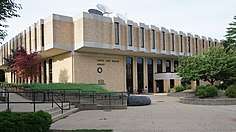
The Curtis Laws Wilson Library is the main academic library on campus.[39] Wilson served as dean of the school from 1941 to 1963. The library's third floor is strictly a quiet study area with multiple rooms circling around the main area. The IT Helpdesk Walk-In Center is located on the first floor. The Miner Break Cafe (currently a Starbucks) is also located in the front right corner of the first floor.
The basement of the library is a quiet study area and is also home to several campus organizations, including:
- Video Communications Center, which provides video services to the university and produces distance education courses.[40]
- KMST, a radio station licensed in Rolla, Missouri; in 2017, operations moved to the University of Missouri–St. Louis
- State Historical Society of Missouri, Research Center-Rolla, which provides access to records and papers relating to area individuals, families, and organizations[41]
- University Archives, which houses the historical, legal and cultural records of the University[42]
Havener Center
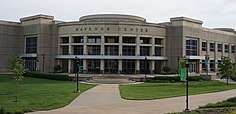
The Havener Center is a multipurpose campus center for student life and activity. It is named for entrepreneur Gary Havener, a 1962 graduate in mathematics. It was dedicated in 2005 to house the Student Life offices, the campus bookstore, a food court, a gameroom, meeting space, etc.
Hasselmann Alumni House
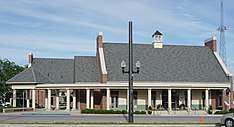
The Hasselmann Alumni house was dedicated in 2015 as the home for the Miner Alumni Association and as a venue for campus and community events. It is named for Karl Hasselmann, a 1925 graduate in mining engineering, who had a prominent career in the oil industry. The Miner Alumni Association was organized in 1921 and publishes the Missouri S&T Magazine (formerly the MSM Alumnus). Alumni and other professionals also support the institution through discipline-specific academics which elect members for contributions to their professions and to the campus. These S&T groups serve an advisory role and include the Academy of Chemical Engineers, the Academy of Civil Engineers, the Academy of Computer Science, the Academy of Electrical and Computer Engineering, the Academy of Engineering Management, the Academy of Mechanical and Aerospace Engineers, the Academy of Miner Athletics, and the Mines and Metallurgy Academy.
The Puck
The Puck is a small, circular stage in the center of the campus.[43] It is used for many student events, and is used extensively during St. Patrick's Day to host different events. It is a common gathering area, and tours given to new students often start at the landmark. Every year it is refaced to reflect the current "Best Ever" Saint Patrick's Day.
Solar Village

Officially opened in December 2010,[44] the Solar Village consists of four entries by Missouri S&T in the U.S. Department of Energy Solar Decathlon.[45] Students, staff, faculty, and donors of Missouri S&T designed, constructed, and competed homes in each of the first four Decathlons including the Solar House in 2002,[46] the Prairie House in 2005,[47] the Solar House in 2007,[48] and the Show-Me House in 2009.[49] In 2012, the Solar Village was one of two highlights in a video short that won recognition from Second Nature and a Climate Leadership Award for the campus.[50] In 2014, the Solar Village was expanded to include a microgrid system and an electric car charging station,[51] and in 2016, Missouri S&T announced a second, EcoVillage, composed of Decathlon entries including the 2013 Chameleon House and the 2015 Nest Home.[52]
Academics
| University rankings | |
|---|---|
| National | |
| Forbes[53] | 246 |
| THE/WSJ[54] | 184 |
| U.S. News & World Report[55] | 157 |
| Washington Monthly[56] | 47 |
| Global | |
| ARWU[57] | 501–600 |
| QS[58] | 651–700 |
| THE[59] | 501–600 |
| U.S. News & World Report[60] | 777 |
Rankings
Recent school rankings include:
- Missouri S&T was ranked No. 3 in the "top 10 places to get an engineering degree in the U.S." by USA Today (2016).[61]
- In 2015, Business Insider ranked Missouri S&T No. 5 among the "most underrated colleges in America".[62]
- Missouri S&T was ranked No. 89 in the "best graduate school engineering programs in the U.S." and ranked No. 61 in the "best doctorate engineering programs in the U.S." by U.S. News & World Report (2018).[63][64] In 2019, the same magazine ranked Missouri S&T at No. 82 among the "best graduate engineering schools".[65][66]
- Missouri S&T was ranked No. 25 in the "top 25 STEM-centric schools" by Forbes (2018).[67]
- Missouri S&T was ranked No. 42 in the United States for "40-year return on investment, or net present value (NPV) with an average return of $1,548,000 for a bachelor's degree recipient" by the Center on Education and the Workforce (2019).[68]
Nuclear reactor
The school operates the 200 kW Missouri S&T nuclear reactor on-campus for educational, training, and research purposes. It became the first nuclear reactor to have become operational in Missouri, and first achieved criticality in 1961.
Experimental mine
This limestone mine is located near the main campus and is used for the teaching and research activities of the Department of Mining Engineering. The facilities, which cover 25 acres, include the mine and adjacent surface dolomite quarries. The mine supports student competition teams, such as the mine rescue team, and the annual "Haunted Mine" Halloween event. The mine has been used by the school since 1921.
Electromagnetic Compatibility Laboratory
The Electromagnetic Compatibility (EMC) Laboratory supports related research. The Missouri University of Science and Technology Electromagnetic Compatibility Consortium is a broad partnership of digital electronics companies committed to funding electromagnetic compatibility research through this facility.
Student engineering projects
The Student Design & Experiential Learning Center (SDELC)[69] was established in 2000 to better support the various multi-disciplinary student design teams. In 2004, the Center's mission expanded to provide experiential learning in academic courses, identify and support student service learning projects within the curriculum, and support ad-hoc student teams in specialty academic events involving multi-disciplinary student research.
By 2006, the SDELC had expanded to ten student design teams. The center's expanded mission involved better funding and offering support and resources to multi-disciplinary project teams that had a research base to their activities. The SDELC provided academic credit opportunities in the form of three, one-hour classes on design, leadership and communication. The center also offers a half-credit course on experiential design through the Residential College (RC) program which has a per-semester enrollment of over 100 students engaged in hands-on learning projects. The SDELC's student design teams, research teams and projects, and academic courses are the foundation of experiential learning at Missouri S&T.[69]
Solar House
The Missouri S&T Solar House Team, designs and builds a house that is completely sustained by energy collected directly from the sun.[70] After the house is built on campus, it is disassembled and transported to Washington, D.C. for the Solar Decathlon, a month-long competition. The Solar House Team placed 11th overall in both 2007[71] and 2009 out of a total of 20 teams. The team is one of only three teams to compete in four decathlons, and one of two teams to compete in four consecutive decathlons. The 2011 Decathlon is the first that Missouri S&T did not participate, but the Solar House Team is back in the 2013 Decathlon in Irvine, California. The team took first place in the Energy Balance category at the 2005 competition. At the 2002 competition the team took first place in Refrigeration, second place in Energy Balance and third in Hot Water. In 2002 and 2005, the Missouri S&T team took 9th place out of 14 teams and 7th place out of 18 teams respectively. After competition, the homes are returned to the Solar Village on the S&T campus where they are rented as student housing.
Engineers Without Borders
Missouri S&T's chapter of Engineers Without Borders has four ongoing international projects in Guatemala, Ecuador, and Bolivia. Over one hundred students are part of a team that works to develop sustainable solutions to engineering problems, such as lack of access to drinking water, in developing countries.[72]
Advanced Aero-Vehicle
The Advanced Aero-Vehicle Group constructs a remote controlled airplane for the annual Society of Automotive Engineers' Aero Design competition. The project is of interest mainly to aerospace engineering students, but students from other disciplines are also on the team. The Advanced Aero Vehicle Group also constructs a rocket every year. The rocket competes in the USLI competition hosted by NASA, in which the rocket must carry a payload one mile into the atmosphere. The AAVG group is also working on a research and development subgroup to complement the existing plane and rocket groups.
Human Powered Vehicle
The Missouri S&T Human Powered Vehicle Team demonstrates the engineering excellence of its members via a human-powered vehicle. The team promotes alternative energy technology while providing tomorrow's engineers with hands-on experience in applying classroom knowledge. Through the spirit of intercollegiate competition, this project hopes to foster leadership, teamwork and the continuous advancement of technologies for the betterment of humanity. The Missouri S&T Human Powered Vehicle Team competes annually at the American Society of Mechanical Engineers Human Powered Vehicle Challenge in both West and East Coast Competitions. The team has placed among the top two overall in 14 of 16 competitions, and holds the female sprint record of 41.8 mph and male sprint record of 48.6 mph.[73] In 2010, the team swept both the East and West Coast competitions and placed first in every event: Design, Male Drag Race, Female Drag Race and the Endurance Race, giving the team 1st Place Overall and National Speed Class Champions.[74] In 2015, the team placed second overall in the ASME West Competition and first overall in the ASME East Competition, in the speed class.[75][76]
Formula SAE
The Missouri S&T Formula SAE team constructs a small formula-style race car every year, suitable for mass production and sale to weekend autocrossers. The team competes in Brooklyn, Michigan against more than 100 other teams from universities around the world. The vehicle's cost, sales presentation, engineering design, acceleration, braking and racing performance all factor into its final score. The team has placed in the top ten in eight of the past twelve competitions, including first-, second- and fourth-place finishes.[77]
Concrete Canoe
The Missouri S&T Concrete Canoe Team designs and constructs a concrete canoe and races it on a lake in regional and national competitions. The team has participated in concrete canoe competitions since the 1970s. The entire project, including fundraising and construction, is completed by the students. The team took third place in 2004.[78]
Solar car
Missouri S&T's solar car team has met with much success. Every two years, the team constructs a single-passenger car, its top covered with solar cells, that runs exclusively on solar power. The car houses lithium ion batteries, which are much lighter than conventional lead-acid batteries. Every time the car is rebuilt, changes make it lighter and more efficient. The team regularly enters solar car races in the United States and occasionally enters international races. The car claimed first place in Sunrayce '99, first place in the 2000 Formula Sun Grand Prix, fourth place in the Australian World Solar Challenge in 2001, second place in the 2001 American Solar Challenge, and first place in the 2003 American Solar Challenge. In 2016, the team placed fourth in the American Solar Challenge after not participating for six years.
Satellite Project
The Missouri S&T Satellite Project team began as an Aerospace engineering course (AE301 Spacecraft Design) when NASA held a contest for a 2-year development and build project (Nanosat program) that had to accomplish its goals in the harsh environment of space. After taking third place in Nanosat-4, the team continued perfecting its twin satellites for spaceflight and entry into the Nanosat-6 competition. During this cycle, the team was awarded "Best Outreach"[79] for its work at encouraging an interest by local school students in STEM-related fields. The team placed second during Nanosat-7, beating rival MIT.[80] With their legacy twin-satellite design and feedback from the AFRL sponsors, the team went on to win Nanosat-8 in 2015.[81]
Robotics
The S&T Robotics Team participates annually in the Intelligent Ground Vehicle Competition (IGVC).[82] The team builds autonomous vehicles that traverse obstacle courses consisting of lane markers and obstacles. The current vehicles are designed to be omnidirectional so that they can easily drive around obstacles. Typically there are 30–50 students on the team and two faculty advisers. The students handle all design and management aspects of the team but occasionally receive help from technicians to fabricate parts.
Mars Rover
The S&T Mars Rover design team finished in first place at the 2017 international University Rover Challenge competition held June 1–3, 2017, in Hanksville, Utah. Missouri S&T's Mars Rover, named Gryphon, was designed and built by the students. The team developed custom circuitry for the rover, machined the aluminum and carbon-fiber support structure, developed durable wheels for terrain mobility, and 3-D printed gears used in the rover.[83]
Athletics
Missouri S&T athletic teams are known as the "Miners" and the women's teams are referred to as the "Lady Miners". The name comes from the university's history as a mining school. Missouri S&T competes at the NCAA Division II level in thirteen sports and is a member of the Great Lakes Valley Conference (GLVC) for most sports, and the New South Intercollegiate Swimming Conference (NSISC) for men's swimming.[84]
Club and intramural sports
Club sports associated with Missouri S&T include ultimate frisbee,[85] lacrosse, rugby union, roller hockey, trap and skeet,[86] tennis, baseball,[87] and water polo.[88]
Intramural sports have a very large following at the Missouri S&T. With over 60 men's teams and over 10 women's teams, sports are arranged into divisions. Thirty different sports are contested each year: golf, softball, swimming, ultimate, flag football, billiards, badminton, volleyball, racquetball, bowling, basketball, table tennis, tennis, track, weightlifting, and soccer.
Student life
The Missouri S&T event calendar includes current campus events.[89]
There are over 200 student organizations at Missouri S&T, including student government, professional societies, community service organizations, and religious and cultural groups.[90]
Student media
The student-run newspaper at Missouri S&T, The Missouri Miner, is published every Thursday during the school year and can be read online.[91] In February 2007, the paper threatened to sue the school because the university cut funding.[92] After a one-school-year break for many reasons including a funding cut, The Missouri Miner continued publication in the fall semester of 2009.
Production of the university's RollaMo yearbook is handled by undergraduate students.[93]

Amateur radio station, WØEEE, founded in 1931 and run by the Amateur Radio Club, was the first campus club at MSM and is one of the oldest student/college amateur stations in the US.[94] The club is located in Emerson Electrical Company Hall.
Two broadcast radio stations are associated with Missouri S&T: KMNR, previously known as KMSM, is a student-run, freeform radio station whose music playlist varies with the mood and inclination of the DJ, with some playing caller requests. Every year KMNR hosts two concerts – Freakers Ball in the fall and MasqueRave (formerly Glitter Ball) in the spring. KMST, previously known as KUMR, is a member-supported public radio station, typically playing classical, bluegrass and jazz and National Public Radio programs. On July 16, 2007, KUMR officially changed its call letters to KMST, in advance of the change of name from "University of Missouri–Rolla" to the "Missouri University of Science and Technology". In 2017, KMST's broadcast operations were transferred to the University of Missouri–St. Louis.
Honor societies
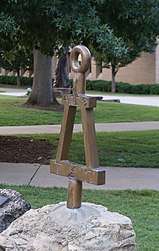
Honor societies with chapters at Missouri S&T include:
- Alpha Chi Sigma, Chemical Sciences
- Alpha Nu Sigma, Nuclear Engineering
- Alpha Sigma Mu, Metallurgy and Materials Engineering
- Blue Key
- Chi Epsilon, Civil Engineering
- Eta Kappa Nu, Electrical and Computer Engineering
- Keramos, Ceramic Engineering and Material Science Engineering
- Kappa Mu Epsilon, Mathematics
- Omega Chi Epsilon, Chemical Engineering
- Phi Alpha Theta, History
- Phi Eta Sigma, First-year students
- Pi Epsilon Tau, Petroleum Engineering
- Pi Tau Sigma, Mechanical Engineering
- Psi Chi, Psychology
- Sigma Gamma Tau, Aerospace Engineering
- Sigma Pi Sigma, Physics
- Sigma Tau Delta, English
- Tau Beta Pi, Engineering
- Upsilon Pi Epsilon, Computer Science
Greek life
Approximately 22% of the undergraduate student body belongs to a social Greek organization.[95] There are 4 sororities and 20 fraternities, which collectively raise over $125,000 annually toward various philanthropies.[96][97]
The nationally recognized fraternities with chapters at Missouri S&T are:
The nationally recognized sororities with chapters at Missouri S&T are:
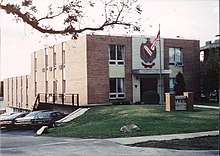

The Beta-Eta chapter of Tau Kappa Epsilon was founded at the Missouri School of Mines and Metallurgy on March 8, 1947 – the fraternity's 55th chapter. It remains active at Missouri S&T and has a chartered alumni association.[98][99] As of spring 2020, the chapter has initiated 1,220 members and received 61 international awards.[100] The Beta-Eta chapter was recognized internationally as a "Top TKE Chapter" for 2016–2017, the fraternity's highest recognition for a chapter.[101] In 2017, the Tau Kappa Epsilon chapter at Missouri S&T completed construction of a new chapter house on Fraternity Row where the old Delta Sigma Phi round house was located.[102][103] The former TKE house was demolished in 2020 after asbestos abatement in 2019.[104][105]
Traditions
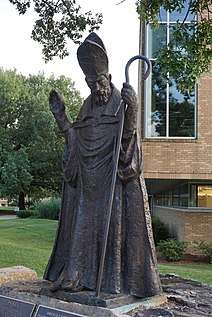
St. Patrick's Day is the largest annual celebration and predominant cultural event at Missouri S&T, with each year's observance touted as the "Best Ever!". During St. Pat's, students wear green sweatshirts (which are sold as fund-raisers throughout the season), carry shillelaghs and party (including drinking green beer). One tradition, observed primarily among fraternities, is the "killing" of rubber snakes in commemoration of St. Patrick's mythical banishing of snakes from Ireland. Along with snake invasion comes the tradition of Follies. Students meet daily at "the Puck" (a short cylindrical stage bearing a large shamrock) to hear jokes and participate in short competitions. On the third day of Follies, students move to the town's band-shell to participate in the ceremonial arrival of St. Pat's Court. The day after Follies, students participate in "Gonzo and Games". Gonzo and Games are two days of elaborate games in which different organizations compete. Friday of St. Pat's week is concluded with Coronation, a ceremony where the Queen of Love and Beauty is announced. The final event of St. Pat's week is a Saturday morning parade on Pine Street, which is painted green by St. Pat's Board Alumni. This parade is known throughout the United States and boasts well over one hundred floats and participating groups. The rationale for the celebration is the notion that St. Patrick is the patron saint of engineers.[106][107] The recognition of St. Patrick as the "Patron Saint of Engineers" began in 1903 when the Engineering students of the University of Missouri in Columbia claimed St. Patrick's Day to be a holiday for engineers.[108] The tradition has remained to this day and has been adopted by many other schools across the nation. St. Patrick's Day 2008 marked the one hundredth consecutive year of St. Patrick's Day celebrations at Missouri S&T.[109] The university cancelled all school-sanctioned St. Patrick's Day celebrations for the first time in 2020 due to the COVID-19 pandemic.[110]
Notable faculty
|
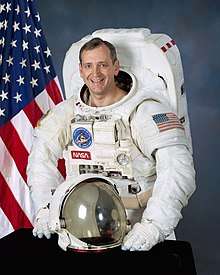 Thomas Akers 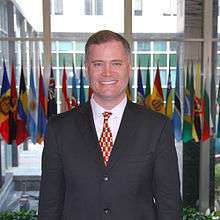 Daniel Oerther |
Notable alumni
References
- https://www.umsystem.edu/about-us/history Archived March 26, 2019, at the Wayback Machine umsystem about us
- "UM Seal Guidelines and History". Curators of the University of Missouri. Archived from the original on November 29, 2010. Retrieved November 19, 2009.
- "University of Missouri System Style Guide" (pdf). Curators of the University of Missouri. September 7, 2018. Archived (PDF) from the original on February 28, 2019. Retrieved February 27, 2019.
- "Missouri University of Science & Technology - Profile, Rankings and Data". U.S. News & World Report. Retrieved May 25, 2020.
- "Facts and Figures" (PDF). University of Missouri System. August 16, 2019. p. 1. Retrieved May 25, 2020.
- Careaga, Andrew (August 1, 2019). "Dr. Mohammad Dehghani joins Missouri S&T as chancellor". Missouri S&T. Retrieved August 2, 2019.
- "Dr. Stephen Roberts named interim provost, Dr. Richard Brow interim deputy provost". Rolla Daily News. June 27, 2019. Retrieved June 29, 2019.
- "Full-Time Instructional Faculty by Academic Rank and Gender" (PDF). Missouri University of Science and Technology. Retrieved May 25, 2020.
- "Faculty and Staff Data, Faculty and Staff Headcount Demographics". Missouri University of Science and Technology. Retrieved May 25, 2020.
- "Enrollment Grid" (PDF). Registrar (Missouri S&T). September 17, 2019. Retrieved May 25, 2020.
- Missouri University of Science & Technology, U.S. News & World Report
- "Missouri S&T – Color". Retrieved May 19, 2016.
- "Joe Miner". mst.edu. Retrieved April 3, 2018.
- "Southeast Missouri Mining and Milling". Doe Run Company. 2004. Archived from the original on March 2, 2010. Retrieved April 5, 2010.
- 7 U.S.C. § 304
- "Full text of "History Of The University Of Missouri School Of Mines And Metallurgy 1871 1946"". Archive.org. Retrieved December 27, 2011.
- "Rolla Building History". Web.mst.edu. Retrieved December 27, 2011.
- "General Facts and Information About Missouri S&TR, Nuclear Reactor". Missouri University of Science and Technology. Retrieved December 17, 2017.
- "Missouri S&T designated as highly selective". Columbia Daily Tribune. June 8, 2018. Retrieved December 29, 2018.
- Careaga, Andrew (June 7, 2018). "Missouri S&T moves to 'highly selective' admissions status". Missouri University of Science and Technology. Retrieved December 29, 2018.
- James Sidney Rollins, memoir – William Benjamin Smith – Google Books. Books.google.com. 1891. Retrieved December 27, 2011.
- "Curators approve UMR name change". news.mst.edu. Missouri S&T Office of Public Relations. April 6, 2007. Archived from the original on August 17, 2009. Retrieved January 14, 2009.
- "Missouri S&T, Index". Chancellor.mst.edu. Retrieved December 27, 2011.
- Carney III, John F. (November 2006). "The Case for a Name Change". University of Missouri–Rolla. Archived from the original (ppt) on July 25, 2011. Retrieved May 10, 2016.
- "Missouri School of Mines & Metallurgy University of Missouri – Rolla Directors, Deans and Chancellors" (PDF). University of Missouri–Rolla. Archived from the original (PDF) on June 9, 2010. Retrieved September 4, 2013.
- "A History of Leadership". Missouri University of Science and Technology. Retrieved September 23, 2019.
- "Through the Years: MSM/UMR/Missouri S&T History Facts". Archives.mst.edu. Archived from the original on April 26, 2012. Retrieved December 27, 2011.
- Sanders, Matthew (August 21, 2018). "Missouri S&T begins nationwide chancellor search". KMIZ. Retrieved December 29, 2018.
- Careaga, Andrew (May 16, 2019). "Nationally regarded engineer and academic leader chosen for chancellor at Missouri S&T". Missouri University of Science and Technology. Retrieved May 17, 2019.
- Potter, Sarah (November 6, 2019). "In inaugural State of the University address, Chancellor Dehghani promotes S&T as "destination of choice"". Missouri University of Science and Technology. Retrieved December 6, 2019.
- James, Kristen (January 19, 2012). "Missouri S&T Announces New Chancellor". KOMU-TV. Retrieved January 20, 2012.
Wray was named interim chancellor back in August 2011 [and] began serving his term on September 1, 2011, the day after Carney retired
- "Missouri S&T names new chancellor". St. Louis Post-Dispatch. January 19, 2012. Retrieved January 20, 2012.
- "Schrader takes the helm". Discover Missouri S&T. Missouri S&T. Archived from the original on April 9, 2012. Retrieved April 4, 2012.
Schrader joined Missouri S&T on April 2, 2012
- Careaga, Andrew (March 6, 2017). "Missouri S&T chancellor accepts Wright State presidency". Missouri S&T. Retrieved March 9, 2017.
- Careaga, Andrew (April 28, 2017). "Christopher Maples named interim chancellor-designate". Missouri S&T. Retrieved June 8, 2017.
- Missouri S&T Stonehenge Website Archived October 12, 2008, at the Wayback Machine
- Missouri S&T Stonehenge FAQ page Archived April 12, 2009, at the Wayback Machine
- Technology, Missouri University of Science and. "About Leach Theater". leachtheatre.mst.edu. Retrieved April 3, 2018.
- "Curtis Laws Wilson Library". Missouri University of Science and Technology. Retrieved April 4, 2007.
- "Video Communications Center". Missouri University of Science and Technology. Retrieved March 2, 2017.
- "Rolla Research Center". The State Historical Society of Missouri. Retrieved February 8, 2018.
- "Archives". Missouri University of Science and Technology. Retrieved February 8, 2018.
- "Visitor Map" (PDF). Missouri University of Science and Technology. Missouri University of Science and Technology. Archived from the original (PDF) on May 1, 2015. Retrieved January 16, 2016.
- "Solar Village Tour". Rolla Daily News. December 23, 2010. Retrieved July 30, 2016.
- "The Decathlon is Over. Now What? How much influence the Solar Decathlon has had on architecture or sustainable technology is difficult to gauge". Architect: The Magazine of the American Institute of Architects. December 31, 2002. Retrieved November 11, 2011.
- "University of Missouri–Rolla: Leading the Way". U.S. Department of Energy. December 31, 2002. Retrieved July 30, 2016.
- "University of Missouri–Rolla: Building on the Past". U.S. Department of Energy. December 31, 2005. Retrieved July 30, 2016.
- "University of Missouri–Rolla: Returning to the Neighborhood". U.S. Department of Energy. December 31, 2007. Retrieved July 30, 2016.
- "Team Missouri: Showing the World the Possibilities of Solar". U.S. Department of Energy. December 31, 2009. Retrieved July 30, 2016.
- "S and T Campus to Celebrate Climate Leadership Award with Ice Cream Social". Rolla Daily News. June 16, 2013. Retrieved July 30, 2016.
- "Microgrid Unveiled at Solar Village". Rolla Daily News. July 18, 2014. Retrieved July 30, 2016.
- "S and T's second solar housing complex named EcoVillage". Rolla Daily News. April 15, 2016. Retrieved July 30, 2016.
- "America's Top Colleges 2019". Forbes. Retrieved August 15, 2019.
- "U.S. College Rankings 2020". Wall Street Journal/Times Higher Education. Retrieved September 26, 2019.
- "Best Colleges 2020: National University Rankings". U.S. News & World Report. Retrieved September 8, 2019.
- "2019 National University Rankings". Washington Monthly. Retrieved August 20, 2019.
- "Academic Ranking of World Universities 2020". Shanghai Ranking Consultancy. 2020. Retrieved August 15, 2020.
- "QS World University Rankings® 2021". Quacquarelli Symonds Limited. 2020. Retrieved June 10, 2020.
- "World University Rankings 2020". THE Education Ltd. Retrieved September 14, 2019.
- "Best Global Universities Rankings: 2020". U.S. News & World Report LP. Retrieved October 22, 2019.
- Stockwell, Carly (November 18, 2016). "The Top 10 Schools in the U.S. for an Engineering Degree". USA Today. Retrieved January 22, 2018.
- Hair, Calley (February 10, 2018). "Ranking the 50 most 'underrated' colleges in the U.S." USA Today. Retrieved December 29, 2018.
- "Missouri University of Science & Technology". U.S. News & World Report. Retrieved January 22, 2018.
- "Missouri University of Science & Technology". U.S. News & World Report. Retrieved January 22, 2018.
- "Best Engineering Schools: Missouri". U.S. News & World Report. 2019. Retrieved April 2, 2019.
- Careaga, Andrew (March 13, 2019). "College celebrates rise in graduate engineering rankings". Missouri S&T. Retrieved April 2, 2019.
- Coudriet, Carter (August 21, 2018). "Top 25 STEM Colleges 2018". Forbes. Retrieved September 2, 2018.
- RDN Reports (November 15, 2019). "The Million-dollar Degree: Missouri S&T Tops in State, Says Georgetown ROI Study". The Rolla Daily News. Retrieved June 20, 2020.
- "Student Design & Experiential Learning Center". design.mst.edu. Missouri University of Science and Technology. Retrieved July 21, 2011.
- "S&T Solarhouse Team". Solarhouse.mst.edu. Retrieved July 18, 2015.
- "UMR's solar house is heading home". news.mst.edu. Missouri S&T Office of Public Relations. October 23, 2007. Retrieved January 14, 2009.
- "Missouri S&T EWB Chapter". Engineers Without Borders USA Missouri S&T Chapter. Retrieved February 27, 2019.
- "HPVC Results". asme.org. ASME. Retrieved February 5, 2010.
- "Human Powered Vehicle Challenge: Results". ASME Community. Retrieved December 18, 2019.
- "Rose-Hulman and Missouri S&T win top Human Powered Vehicle honors". Mechanical Engineering-CIME. August 2015. Retrieved December 18, 2019 – via The Free Library.
- Ehrhard, Peter (May 11, 2015). "Missouri S&T's HPVC team wins national competition". Missouri University of Science and Technology. Retrieved December 18, 2019.
- "SAE Collegiate Design Series". students.sae.org. SAE International. Retrieved October 7, 2009.
- "Concrete Canoe Archives". Experience This. Missouri S&T. April 18, 2008. Retrieved July 9, 2008.
- Callier, Maria (January 25, 2011). "Nanosat-6 Flight Competition Review Winners Announced and Nanosat-7 Competition Begins". Wright-Patterson Air Force Base. Archived from the original on March 4, 2016. Retrieved October 11, 2015.
- Fulps, Linda (March 26, 2013). "If it ain't broke ..." Missouri University of Science and Technology. Retrieved October 11, 2015.
This is the best the team has done in the competition – we placed higher than MIT
- Ehrhard, Peter (January 30, 2015). "Missouri S&T satellite team wins national Air Force competition". Missouri S&T. Retrieved October 11, 2015.
- "Intelligent Ground Vehicle Competition". IGVC. Retrieved July 18, 2015.
- Careaga, Andrew (June 4, 2017). "Missouri S&T team wins international Mars rover competition". Missouri S&T News & Events. Missouri University of Science and Technology. Retrieved November 3, 2017.
- "Missouri S&T, Truman State Lead NSISC Championships". Collegeswimming.com. February 10, 2011. Retrieved April 10, 2011.
- "Miner Threat Ultimate". Miner Threat. Retrieved May 26, 2008.
- "Missouri S&T Trap and Skeet". Missouri S&T Trap and Skeet. Retrieved September 3, 2009.
- "Missouri S&T Club Baseball". Missouri S&T Club Baseball. Retrieved April 16, 2014.
- "Missouri University of Science and Technology: Athletics". Peterson's. Retrieved March 14, 2016.
- "Calendar of Events". calendar.mst.edu. Missouri University of Science and Technology. Retrieved August 6, 2009.
- "Listing of Recognized Student Organizations (RSOs) and Design Teams". Retrieved February 16, 2016.
- "The Missouri Miner | Serving the MSM/UMR/Missouri S&T community since 1915". Mominer.mst.edu. January 28, 2010. Retrieved December 27, 2011.
- "Student Newspaper at Missouri–Rolla Threatens to Sue Over Big Budget Cut". The Chronicle of Higher Education. February 15, 2007. Retrieved January 28, 2008.
- "RollaMO Application for Employment" (MS Word). Retrieved December 30, 2017.
Note: Only undergraduates may apply
- "W0EEE Web Server". Missouri S&T Amateur Radio Club. Retrieved May 26, 2008.
- "Fraternity and Sorority Life". Missouri University of Science and Technology. Retrieved June 20, 2020.
- "Sororities". Missouri University of Science and Technology. Retrieved June 20, 2020.
- "Fraternities". Missouri University of Science and Technology. Retrieved June 20, 2020.
- "Chapters Represented on Campus". Missouri University of Science and Technology Interfraternity Council. June 11, 2017. Retrieved August 8, 2017.
- "Beta-Eta Alumni Association at Missouri University of Science and Technology". Tau Kappa Epsilon. Retrieved July 27, 2017.
- "Beta-Eta Chapter at Missouri University of Science and Technology". Tau Kappa Epsilon. Retrieved May 10, 2020.
- "2016–2017 TKE Award Winners". Tau Kappa Epsilon. August 21, 2017. Retrieved November 19, 2017.
- "TKE Educational Foundation Supports Group in Housing Quest". The Teke. Tau Kappa Epsilon. Winter 2017. pp. 52–53. Retrieved February 8, 2018.
- "Chapter History". Delta Sigma Phi Rolla Alumni. Retrieved July 28, 2017.
- Ehrhard, Peter (December 23, 2019). "TKE house demo planned". Missouri University of Science and Technology. Retrieved May 19, 2020.
- "Asbestos Abatement Project Notification Details". Missouri Department of Natural Resources. Retrieved May 19, 2020.
- Alfred University (April 3, 2007). "St. Patrick". Archived from the original on April 23, 2001. Retrieved April 3, 2007.
- University of Missouri Archives (January 17, 2003). "St. Patrick Was an Engineer". Retrieved April 14, 2007.
- Meade, Mark C. "A History of the College of Engineering at MU". University of Missouri Archives. Retrieved August 31, 2007.
- "History: St. Pat's Celebration Committee". Missouri S&T. Retrieved August 31, 2007.
- Technology, Missouri University of Science and (March 11, 2020). "St. Pat's, Teaching and Learning Technology events canceled due to COVID-19 concerns". News and Events. Retrieved June 10, 2020.
- Staff Writer (December 14, 2011). "To Infinity and Beyond...". Missouri University of Science and Technology. Retrieved January 21, 2018.
- "Thomas Akers: Astronaut and Educator". Missouri University of Science and Technology. Retrieved January 21, 2018.
- "Dr. Delbert E. Day". Missouri University of Science and Technology. Retrieved January 21, 2018.
- Staff Writer (January 13, 2011). "Rolla Hospital’s Cancer Institute Named for Ceramist Delbert Day". American Ceramic Society. Retrieved January 21, 2018.
- "McManus, John C.". Missouri University of Science and Technology. Retrieved January 21, 2018.
- Stoltz, Mary Helen (April 18, 2012). "McManus receives Governor’s Award for Excellence in Teaching". Missouri University of Science and Technology. Retrieved January 21, 2018.
- "Oboh-Ikuenobe, Francisca". Missouri University of Science and Technology. Retrieved January 21, 2018.
- Staff Writer (November 20, 2014). "Oboh-Ikuenobe Named Interim Geology Department Chair at S&T". The Rolla Daily News. Retrieved January 21, 2018.
- "Oerther, Daniel B.". Missouri University of Science and Technology. Retrieved January 21, 2018.
- Staff Writer (March 14, 2013). "Missouri S&T Professor to Guide Three Students’ Brazil Research". The Rolla Daily News. Retrieved January 21, 2018.
- "Worsey, Paul Nicholas". Missouri University of Science and Technology. Retrieved January 21, 2018.
- Nordlinger, Jay (December 20, 2016). "Blowing Up Barbie". National Review. Retrieved January 21, 2018.
External links
| Wikimedia Commons has media related to Missouri University of Science and Technology. |